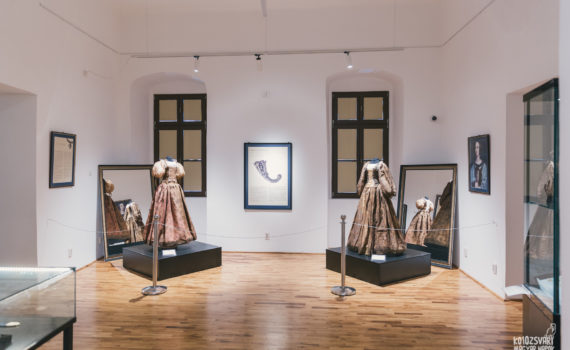
“The horn of plenty. Elements of luxury in the world of the Transylvanian aristocracy”, “Famous photographers in Transylvania in the 19th and the 20th century” and “Orbán Balázs. Travel into the Orient” – these are the three exhibitions, which are hosted and offered free guidance in Romanian by the National History Museum of Transylvania during the Hungarian Cultural Days of Cluj/Kolozsvár 2019.
“The horn of plenty…” is an exhibition of objects of adornment, gowns, hats, bonnets, fans, hunting and party outfits, satin shoes and parade boots, jewelries for women and men, weapons decorated with pearls, furniture with insertions bearing scenes from the novels of Walter Scott, breakfast trolleys, various belts, photo frames – each of the items having its own story as to the way of manufacturing, former owners, as well as recovery and restoration to its present-day status. These are all stories well-known to the museographers and which are, nevertheless, described as the price paid for luxury and image. The visitors of the exhibition may, just as well, find out that one single ball outfit was sometimes worth an entire real estate, that in order to be entitled to organize a hunting party one had to own at least 80 greyhounds and that wearing a certain colour was limited to social status and wealth – a ballgown coloured with saffron was a sign of wealth as the price of saffron was comparable to that of gold, therefore, to be able to make a proper entrance, many chose to engage themselves into debts in order to preserve and consolidate their prosperous image.
The second exhibition consists of photos taken in the 19th and the 20th century.
The visitors may see works signed by the first photographer in Cluj/Kolozsvár, Ferenc Veress, who immortalized the town, who took pictures of building sites where women and children were working shoulder to shoulder with men, and who left thousands of clichés of portraits on glass. Developed and pocessed, we can see the Bánffy counts, count Imre Mikó in a rather bohemian posture, Sándor Petőfi’s beloved actress, Mór Jókai, the writer who was hoping that the photo taken during his visit in Cluj/Kolozsvár would make him look handsome. But we can also see Andrei Şaguna, the Orthodox archbishop of Transylvania, Ioan Fechete-Negruţiu, Greek-Catholic canon, master of the Regular School in Blaj, Florian Porcius, the botanist, or Ambrosiu Cheţianu, master of the Secondary School in Blaj. But there are also collages of photos of Bistriţa/Beszterce by Alexandru Roşu, of Făgăraş/Fogaras by Gábor Szabó, as well as of Baia Mare/Nagybánya by Zoltán Suba. Last but not least, we also have to mention the photos of Samoilă Mârza taken in Alba Iulia/Gyulafehérvár on December 1st, as well as on other different events organized in the memory of Avram Iancu or Horea, Cloşca and Crişan.
The third exhibition, along with a documentary, has been organized in the memory of Balázs Orbán as he was the one who had donated to the Transylvanian Museum Society a whole series of artefacts that set the grounds for the collection of the future National History Museum of Transylvania.
Balázs Orbán set out to Constantinople at the age of 17 to attempt the recovery of the heritage left behind by his grandmother of Greek origin. „It took him 12 years to regain possession over a part of his due heritage, however, having to spend time in the Mediterranian area, he took the opportunity to travel in Egypt, the Holy Land and in Greece” relates Melinda Mitu. The 18 year old, young Orbán Balázs purchased objects found in pyramids, cult objects, as well as other items, among which the beautiful covers of a book of oriental fairytales. These are the basics of the exhibition open for visitors until the end of September.
Free guidance in Romanian is supplied by Diana Varga and Ioana Gruiţă for the first exhibition and by Melinda Mitu for the other two. The next guided tour will take place on Wednesday, August 21st at 1:00 p.m.
Photo: The National History Museum of Transylvania






